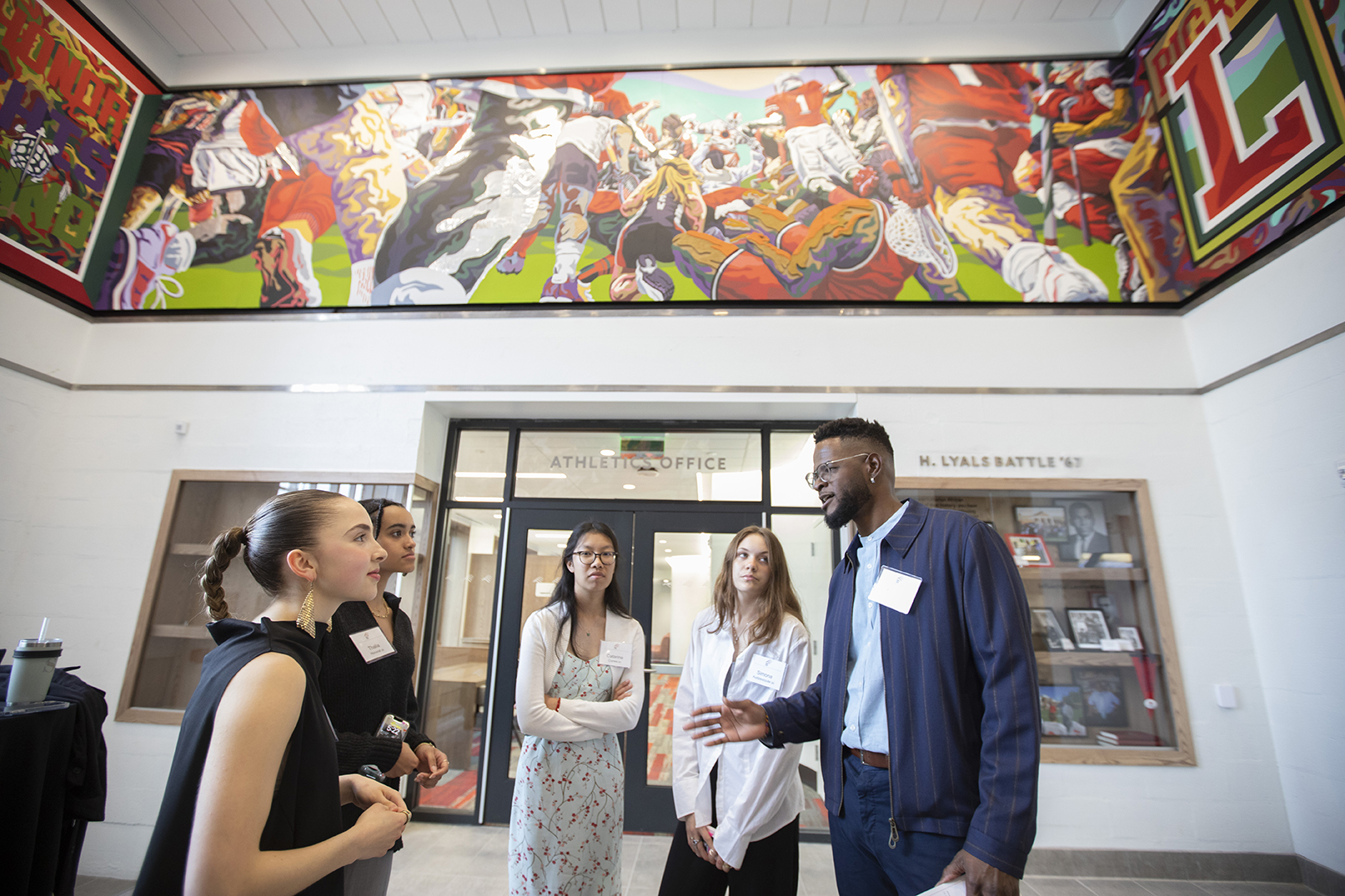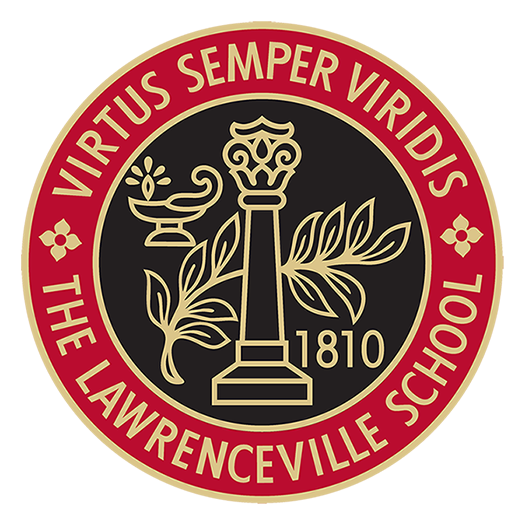

Shortly before the dedication of the Battle-Fitzgerald Atrium on May 16, Artist-in-Residence Stuart Robertson ’11 H’18 and several students discussed the overhead mural on which they collaborated over the course of the year.
Art Imitating Life
Even during his student years, Stuart Robertson ’11 H’18 viewed the Lawrenceville campus as a canvas. From building façades to lengthy corridors, every empty expanse seemed ideal for a mural reminiscent of the vibrant artwork of his native Jamaica. Those murals, noted the School’s first artist-in-residence, reflect the country’s resourceful, expressive, and colorful culture, and often pay tribute to revered community figures.
So, it felt serendipitous when Head of School Steve Murray H’54 ’55 ’63 ’65 ’16 P’16 ’21 engaged Robertson about revitalizing the entrance to the original portion of what is now Tsai Field House. The H. Lyals Battle ’67 and Darrell A. Fitzgerald ’68 Atrium honoring the School’s first two Black students was dedicated on May 16, but months before the stirring ceremony, Robertson understood that his commission to create a vibrant mixed-media installation to ring the walls of the atrium would be an extraordinary learning opportunity for his students.
“It would not be the ethos of the project or the institution,” he said, to create the installation without an experiential education component.
Students applied to work on the installation and were chosen by Robertson. Over the fall and winter terms, sixteen Lawrentians – including one documentary photographer and one videographer – assisted in creating an installation for the Battle-Fitzgerald Atrium.
“There are things that I could not have put into a lesson plan that I’ve taught them while working on this project,” Robertson said.
Robertson’s use of mixed media was “something I’ve never been exposed to before, so it has really forced me to get out of my comfort zone,” student artist Sofia Keith ’25 explained. “It’s something that I now use in my own personal work and that I really value learning from him.”
The artists collaborated closely with Robertson from conceptualization to realization to complete a work that replaces the original, circa-1950 black-and-white images of Lawrenceville athletes in action. The exclusive depiction of white male students reflected the era’s student body, but that composition was neither recognizable nor relatable to students in 2024.
Creating a project that represents today’s Lawrenceville for future Lawrentians comes with “a lot of responsibility,” Keith noted.
“Whenever we got together to brainstorm, Mr. Robertson really emphasized that the installation was so much more than the visuals and the aesthetics,” she said.
The atrium is also anchored by two display cases of archival material featuring photographs, letters, and personal memorabilia representing the triumphs and struggles of Battle and Fitzgerald during their time at Lawrenceville.
“These doors that open into the atrium of this handsome structure … represent the courage of Lyals and Darrell at a very different time in the School’s history,” said Joe Tsai ’82, whose vision inspired the atrium tribute and whose generosity enabled it, at the dedication in May. “Now the door to Lawrenceville is wide open to give the opportunity to students of all ethnicities, and our School is better for it. This Battle-Fitzgerald Atrium is a symbol of our progress, and we’ve come a long way.”
See more photos from the May 16 dedication of the Battle-Fitzgerald Atrium, or learn more about the creation of its mural through the documentary video, Through These Doors, by Lawrenceville’s Seun Aladese.
Q&A with Artist-in Residence Stewy Robertson
Why did you elect to portray Lawrentians not just as athletes, but also in some of the many identities they have at school?
I think the beauty of Lawrenceville is that athletes are also scholars, writers, performers, technicians, and engineers. I don’t know many people who get to be just one thing here. I think it is really important for students to keep in mind that there are multiple parts of you. Students should be able to live through all the versions of themselves.
In what ways did the space, dedicated to the courage of Lyals and Darrell, influence your process?
I’m thinking of them in both Lawrenceville and Civil Rights contexts, trying to imagine what this all means for someone who doesn’t look like me. I’m trying to imagine all the different ways that people are interacting with their story, and then using it as guides for the choices [I made]. Their legacy is what we’re interacting with now – and someday someone is going to interact with our legacy.
Why did you want to involve students in this process?
As an artist-in-residence, I’m exposing them to experiences and information and ideas and lenses. Here, I can show them this is what it’s really like to be an artist; this is what it takes to execute a major creative vision. And all of the risk is mine — it’s up to me to make sure this installation is completed. It’s also a chance for them to be cemented into Lawrenceville history.
What do you want people to feel, think, or experience when they see the installation?
People will be moving through the Atrium, so the goal is to grab your attention and hold it for five or six, maybe 12 seconds. And maybe you’ll start thinking and come back for another minute. Then maybe there’s a day where you come and spend 30 minutes with it because you just need to figure out what it means and what it means to you.
